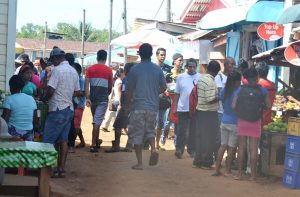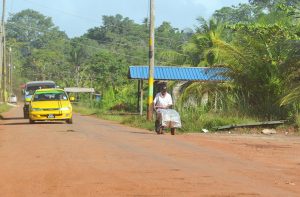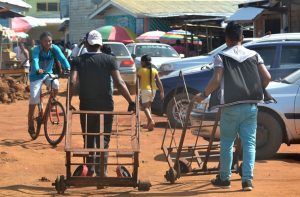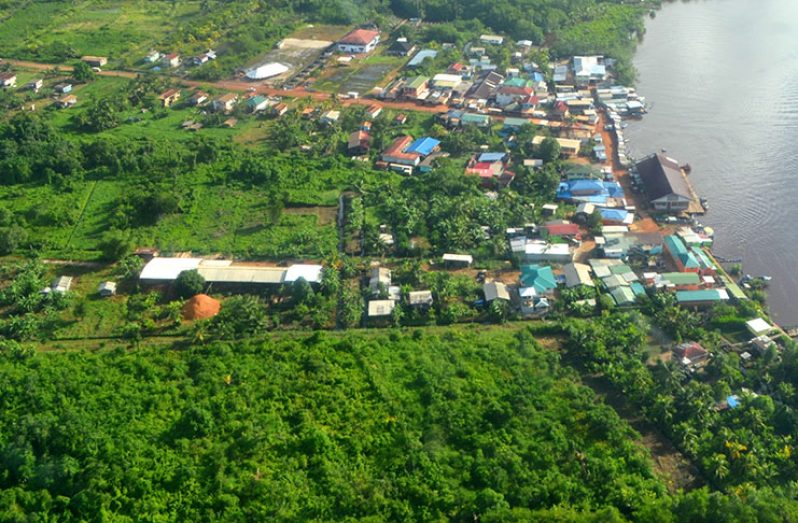IT IS Saturday morning at Kumaka and the atmosphere is buzzing with shoppers, moving cars and buses parked along the road shoulders with a characteristic traffic congestion of the main roadway which snakes around the turns at Mabaruma sub-region’s main business hub.To the first time visitor it may appear confusing. But to persons familiar with the area, the

situation occurs each weekend. Amidst strolling vendors and several dogs roaming the roads, a peculiar sight has been added to the landscape in recent months; the presence of Venezuelan–based Guyanese nationals plying their trade, some of whom barter goods in exchange for food stuff.
Two Saturdays ago, the atmosphere was abuzz, mainly because persons were anticipating the arrival of the MV Northcote. The Transport and Harbours Department (T&HD) ferry usually transports goods and passengers to the area on a fortnightly basis and it was expected later that day. Since it was “boat day “ the road network was busier than usual with buses passing to and fro, through the villages along the main roadway, from as early as 04:00hrs.
At Kumaka, a dog lay beside several cars parked at the waterfront. It is almost 09:00hrs and a meeting of indigenous leaders was in progress at the Kumaka Extension Centre, several fish vendors chopped their fishes in parts for sale to shoppers and as time ticked, a sale was being organised between a young man and two shoppers.
He swung several pairs of shoes across his shoulder, pieces of clothing in his hand and other accessories as he walked between the cars and buses, trying to sell his goods. Then he

encountered two prospective buyers. His unique hairstyle and his broken English accent were distinctive traits among the vendors. He was one of several from the neighbouring country who have been trying to make ends meet, given the ongoing situation across the border. According to residents, the situation was observed during 2016, as the economic condition in Venezuela took a turn downwards.
According to a report in the New York Times last May, supermarket shelves in Venezuela were chronically bare, and power shortages are so severe that government offices were open only two days a week. The healthcare system had collapsed, the crime rate in the Bolivarian Republic had soared and inflation rapidly eroded last year.
The price of oil, Venezuela’s only significant export, had plummeted, which means revenue could fall by 40 percent this year, the report stated. The situation resulted in a number of Venezuela-based Guyanese relocating to the place they once called home, within communities in the North West District.
“They come across with fuel and plastic containers and clothes and take back sugar, rice and even things like toilet paper“, said Michael, a local vendor. He said that the goods brought by the Spanish-speaking individuals to Kumaka are sold at very cheap prices. “A set of bowls, the ones with more than one, you can get that cheap “, he said.
At the Kumaka Waterfront, several stalls lined the edges of the roadway close to the Aruka River – a sight which was almost non-existent prior to the collapse of the Venezuelan economy. The area was once a matter of concern in the past, as water from the meandering Aruka River had almost eroded that section of the waterfront in recent years. However, revetment works were undertaken to the area and it has since stood the test of time.

According to residents, many persons who relocated to Venezuela during the 1980s have returned to the North West in search of greener pastures. In addition, some persons would cross the border to trade items at Kumaka which are difficult to source in their homeland. These include fuel, such as gasoline, which is retailed at approximately G$17,000 per barrel. The cost dropped significantly a month ago when the authorities clamped down on the trade of fuel at the port of Morawhanna. At that time, the price per barrel rose to approximately $28,000.
“We buy gas at about $400 a gallon “, a minibus driver told this publication at Kumaka. He said that when the authorities visit the area, the prices would increase. Last December, Commissioner General of the Guyana Revenue Authority (GRA), Godfrey Statia, spoke on the issue of fuel-smuggling in the area.
“We also know there is fuel-smuggling in the Essequibo, in Morawhanna, we also plan to put a presence at Morawhanna,” Statia noted at a press briefing.
At the remote villages outside Mabaruma, persons would trade mainly food items with Venezuelans across the Amacuro River. The goods are usually bought at Kumaka and ferried to the border location, a practice which is not expected to end anytime soon, as residents noted the humanitarian grounds on which their neighbors are assisted.




.png)









